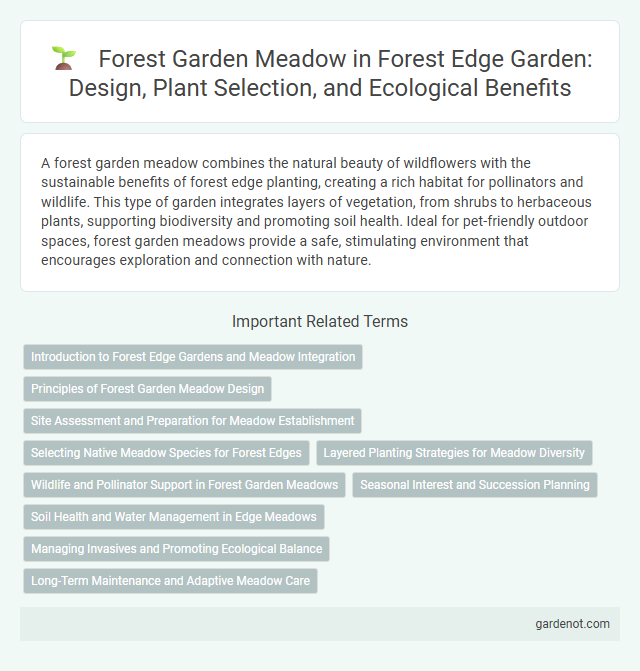A forest garden meadow combines the natural beauty of wildflowers with the sustainable benefits of forest edge planting, creating a rich habitat for pollinators and wildlife. This type of garden integrates layers of vegetation, from shrubs to herbaceous plants, supporting biodiversity and promoting soil health. Ideal for pet-friendly outdoor spaces, forest garden meadows provide a safe, stimulating environment that encourages exploration and connection with nature.
Introduction to Forest Edge Gardens and Meadow Integration
Forest edge gardens create a dynamic interface between woodlands and open fields, enhancing biodiversity and ecological stability. Integrating meadow species within forest edge gardens promotes habitat connectivity, supports pollinators, and enriches soil health through diverse plant interactions. Strategic planting of native grasses, wildflowers, and shrubs in these transitional zones maximizes ecosystem services while maintaining aesthetic appeal.
Principles of Forest Garden Meadow Design
Forest garden meadow design prioritizes biodiversity by integrating native plant species that create layered vegetation structures, enhancing habitat complexity and supporting pollinators. Emphasis is placed on natural succession and species interaction to build resilient ecosystems that efficiently recycle nutrients and conserve soil moisture. Strategic plant placement maximizes sunlight capture while maintaining ecological balance through companion planting and minimal disturbance.
Site Assessment and Preparation for Meadow Establishment
Conducting a thorough site assessment is essential for successful forest garden meadow establishment, focusing on soil composition, drainage patterns, and sunlight availability to determine optimal planting zones. Preparing the site involves removing invasive species, amending soil with organic matter, and ensuring proper grading to promote healthy meadow growth. Selecting native grasses and wildflowers adapted to the local ecosystem enhances biodiversity and resilience of the forest edge meadow over time.
Selecting Native Meadow Species for Forest Edges
Choosing native meadow species for forest edges enhances biodiversity, supports local wildlife, and improves ecosystem resilience. Species like Echinacea purpurea, Solidago canadensis, and Schizachyrium scoparium thrive in transitional zones, offering nectar for pollinators and habitat for small mammals. Incorporating native grasses and wildflowers adapted to soil and light conditions ensures sustainable growth and natural regeneration along forest edges.
Layered Planting Strategies for Meadow Diversity
Forest edge gardens benefit from layered planting strategies that enhance meadow biodiversity by incorporating a mix of grasses, wildflowers, shrubs, and small trees. This multistrata approach promotes habitat complexity, supports pollinators, and improves soil health through varied root structures. Strategic layering creates microhabitats that increase species richness and resilience within the forest garden meadow ecosystem.
Wildlife and Pollinator Support in Forest Garden Meadows
Forest garden meadows provide a rich habitat that supports diverse wildlife, including beneficial pollinators such as bees, butterflies, and native insects critical for ecosystem health. The combination of flowering plants, shrubs, and trees within these meadows fosters abundant nectar and pollen sources, enhancing pollinator foraging opportunities throughout the growing season. Increased biodiversity in forest edge garden meadows promotes natural pest control and contributes to the resilience and sustainability of the entire forest garden ecosystem.
Seasonal Interest and Succession Planning
A forest garden meadow offers dynamic seasonal interest through a diverse mix of perennial flowers, grasses, and edible plants that bloom and fruit from spring to late autumn. Succession planning ensures continuous growth and harvest by carefully selecting species that mature at different times, providing a balanced ecosystem that supports pollinators and wildlife year-round. This approach maximizes plant diversity and productivity, creating a sustainable and visually appealing forest edge habitat.
Soil Health and Water Management in Edge Meadows
Forest garden edge meadows enhance soil health by promoting diverse root systems that improve soil structure and increase organic matter content. Effective water management techniques, such as contour planting and mulching, reduce erosion and maintain moisture levels, supporting both plant growth and biodiversity. These practices create resilient ecosystems that sustain nutrient cycling and optimize water retention in edge meadow environments.
Managing Invasives and Promoting Ecological Balance
Managing invasives in a forest edge garden involves regularly identifying and removing non-native species such as Japanese knotweed and garlic mustard that threaten native biodiversity. Promoting ecological balance requires planting native wildflowers and grasses to support pollinators and improve soil health while providing habitat for local wildlife. Implementing controlled burns or targeted grazing can further maintain meadow health by preventing invasive species dominance and encouraging native plant regeneration.
Long-Term Maintenance and Adaptive Meadow Care
Long-term maintenance of a forest garden meadow involves regular monitoring of plant diversity and soil health to ensure ecosystem balance. Adaptive meadow care includes periodic selective mowing, removal of invasive species, and strategic planting to promote native flora resilience. This approach enhances habitat stability while supporting pollinators and other wildlife over time.
Forest garden meadow Infographic

 gardenot.com
gardenot.com